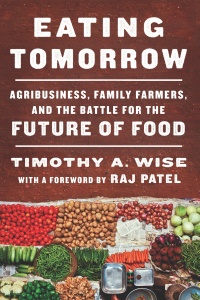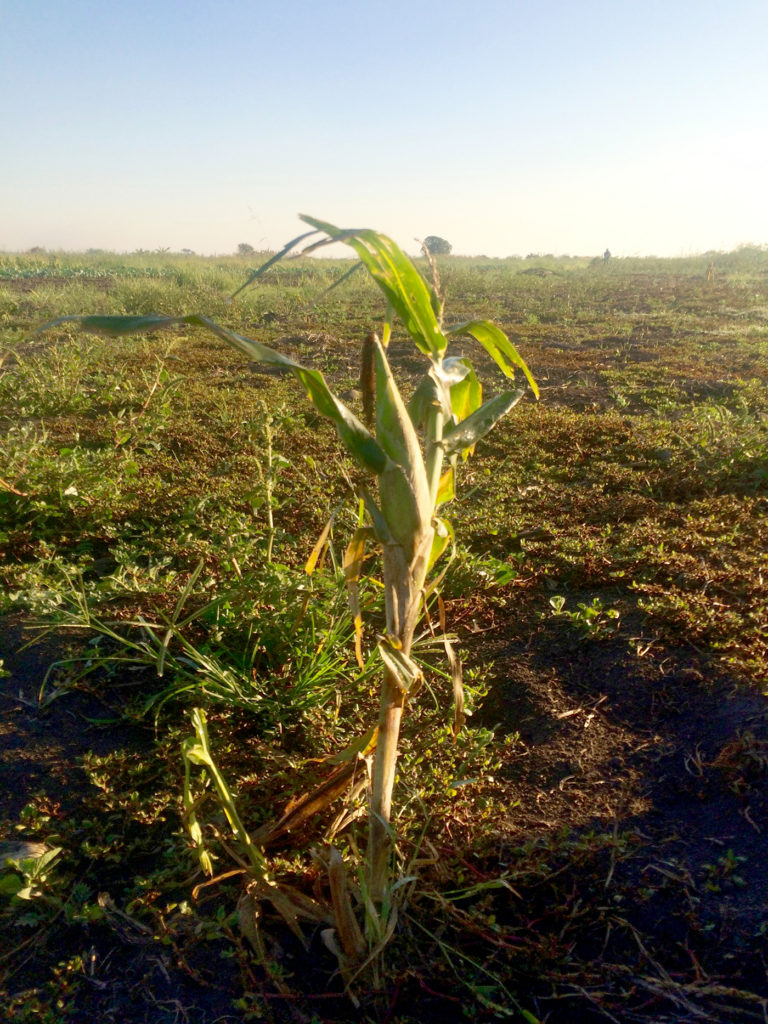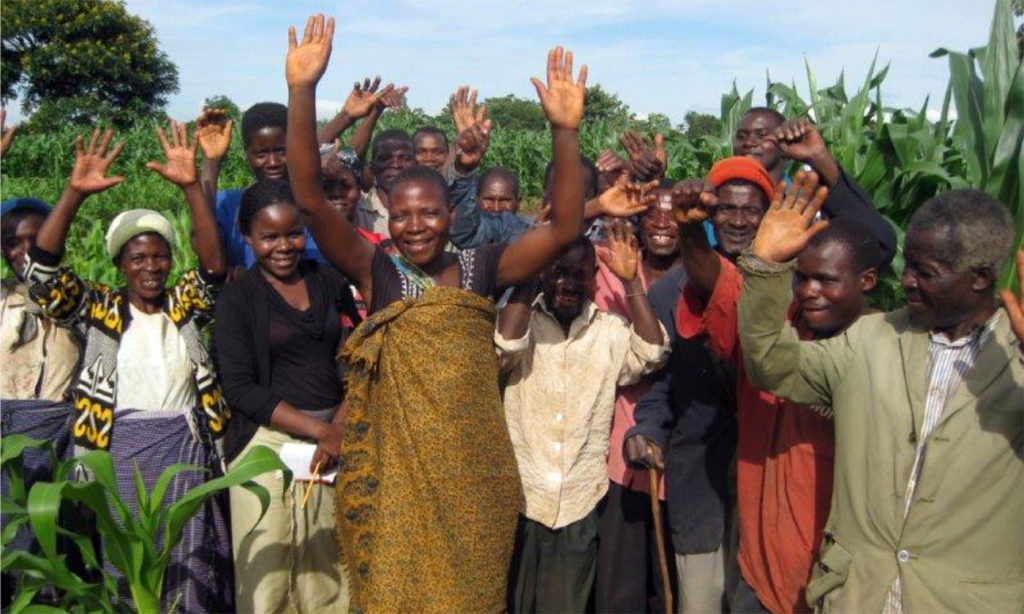Big Ag and the Small-Scale African Farmer

The headquarters of the world’s largest charitable foundation stretch along an entire block near downtown Seattle. There’s a plaza at the entrance, and to one side, a wall embossed in elegant gold lettering proclaims “The Bill and Melinda Gates Foundation.”
Inside those walls, foundation staff dispense billions of dollars every year on health, education, and poverty programs, a process that is sometimes controversial and famously opaque. But the foundation’s “Discovery Center” in front of HQ welcomes the public with glass walls and uplifting exhibits. There’s inspiring narrative about Bill Gates’ mission to use his Microsoft fortune to make the world a better place. And there are displays about the foundation’s work, such as one that reads:
“Many of the world’s poorest people are small farmers—mostly women. They struggle to grow food to feed their families, facing challenges like poor soil and drought. If we help them grown healthy crops and earn more income, we can reduce poverty and hunger on a large scale.”

The display features photographs of farmers in India and Africa in traditional dress, with crops and smiling children. Visitors are invited to “Explore solutions to help farmers increase productivity.” When they place blocks printed with “solutions”—such as genetically engineered golden rice—in the appropriate slots, the display lights up.
The messaging is presumably designed for school kids. But given the foundation’s huge impact on agricultural policy in the developing world, something seems to be missing.
“This is all aspirational. There’s no evidence presented for outcomes,” says Timothy A. Wise, with a gesture toward the display. Wise is a senior researcher at the Small Planet Institute and at Tufts University’s Global Development and Environment Institute who takes issue with the Gates Foundation’s agricultural strategies. In his new book, Eating Tomorrow: Agribusiness, Family Farmers, and the Battle for the Future of Food, he starts with the given that 1 billion people on Earth are chronically malnourished, while farmers around the globe are already struggling with climate change. His central question is one he says the Gates Foundation is not answering: How are we feeding people today to make sure we can all eat tomorrow?
Wise looks for answers on research trips to Africa (Mozambique, Zambia, and Malawi), Mexico and India, visiting farming communities where there is little safety margin and a bad year can mean hunger, even starvation. Each location provides a case study of good or bad practice in the context of a problem that is both global and local: the world food system is dominated by interests and policies that place profit over people and planet. “Everywhere I traveled in researching this book,” he writes, “agribusiness interests were being aggressively promoted, to the detriment of family famers, the environment, and the food and nutritional security of the world’s poor.”

To understand what that has to do with the Gates Foundation, it helps to go back to the “Green Revolution” of the 1960s and ’70s when programs to alleviate hunger pushed industrial farming—high-yield seeds, inorganic fertilizers, and other chemicals—to farmers in Asia and Latin America. The “green” of that era meant plants, not environmentalism, and that Green Revolution, writes Wise, accomplished its mission: “Production increased, feeding growing populations and dissuading restive farmers from joining radical movements for land reform or wholesale revolution.”
Fast forward to 2006 and the launch of a new Green Revolution, this time for Africa, when the Gates Foundation and the Rockefeller Foundation formed the Alliance for a Green Revolution in Africa (AGRA). In 2008, when world food prices spiked and riots followed, governments in many developing countries set out to grow more of their own food. AGRA looked like the organization for the time, writes Wise, and its influence grew. The Gates Foundation, thanks to a massive endowment from Warren Buffett, has given AGRA about $400 million since 2006.
But to many, the Green Revolution for Africa looked like “the new colonialism,” writes Wise: “AGRA preached improved seeds (mainly commercial hybrid and genetically modified varieties), soils (mainly through increased use of synthetic fertilizer), and markets (for the distribution of such inputs and the infrastructure to bring products to market.) And it offered cash payments for those who converted to its particular version of African agricultural development, dispensed as grants to governments, nongovernmental groups, and even for-profit initiatives. The approach was buttressed by expensive farm input subsidy programs (FISPs) which subsidized farmers to use those green-revolution seeds and fertilizers.”
Those subsidies, he writes, were an ideal way to create dependency. Big Ag’s hybrid and GMO seeds must be purchased anew every year, and they’re designed to work best with synthetic fertilizer, pulling African small-scale farmers into a cycle of using subsidies to purchase hybrid seeds and synthetic fertilizers, rather than saving traditional seeds for foods their cultures have developed, grown, and eaten for thousands of years. The plan was to eventually increase yield to the extent that farmers could feed their families, have crops left over to sell, and use the cash to improve their standard of living and buy seeds and fertilizer for next year. Problem is, Wise says, things are not working out that way.
In an interview that began in front of that aspirational display at the Gates Foundation, Wise pointed out what he sees as AGRA’s evidence problem. “In doing research on AGRA it has been striking to me that neither the Gates Foundation, nor AGRA itself, nor the donor governments that contribute to AGRA from the global north, have any published evaluation of the effectiveness of that aid. …They promised when they launched AGRA that their goal was to double productivity and incomes for 30 million African small-scale farmer households by 2021. There’s absolutely no evidence to suggest that that’s happening and they have not offered, that I’ve seen, any evidence that they’re having that effect.”
I reached out to the Gates Foundation and AGRA for comment after speaking to Wise—and passed on his question: “What evidence can you supply that you are achieving a green revolution in Africa?” AGRA’s acting head of communications sent a message citing several reports detailing AGRA’s inputs, like amounts of seeds and fertilizer supplied to farmers. But there was less detailed data for outputs like increases in income or crop yield or nutrition for smallholders and their families. And from the Gates Foundation’s press office, I got an automatic reply acknowledging receipt of my email and then—nothing.
Wise’s book though, isn’t about the Gates Foundation or even AGRA, but rather about what he found is working or not working on the ground to increase yield, incomes, nutrition, and climate resiliency. Take his research in Malawi. In response to food crises in 2002 and 2005 caused by flooding and drought, its government established a FISP—a farm input subsidy program—to provide poor farmers with industrial high-yield seeds and fertilizers. Maize production increased (although so did rain), and Malawi was even able to export food. On closer inspection, writes Wise, “hunger indicators showed little improvement, if any. But the subsidies were undeniably a boon to multinational seed and fertilizer companies.” Looking closer, he concludes that “I saw Malawi’s FISP creating a market for seeds and fertilizers where one barely existed. In the process, they were promoting a long-term transition away from sustainable practices of seed-saving, inter-cropping, and using compost for fertilizer.”
That transition is bolstered by public-private partnerships that require participating African governments to adopt agribusiness-friendly laws and policies. But Americans don’t have to travel far afield to see Big Ag wielding huge economic and political power, as Wise describes in his chapter about Iowa, where government support led to the “cornification” of the state: corn feeds factory farms that feed toxic runoff into rivers and eventually, the Gulf of Mexico. Along the way, an army of lobbyists ensure government can’t or won’t impose adequate pollution controls. It’s hardly a model to export to the rest of the world, especially at a time of impending climate crisis, but cultural hubris dies hard.
So does myth and hyperbole, Wise says. “Probably the most misleading piece of it is that it’s the seeds and the fertilizer that are the solution. The newest research says it’s irrigation. One study said irrigation accounted for 50% of all the yield increases in India during the Green Revolution period. And that’s really notable because they’re not doing that in Africa. Typical of a tech guy like Gates, Green Revolution 2.0 included new features, but it left out some of the most important old ones, like an update to your phone that destroys one of the things that you love. That’s a huge issue, because with climate change, sustainable gravity-fed small scale irrigation is a lifesaver.”

But there’s hope to be found in another strategy proven to improve the lot of small-scale famers, says Wise—and that is organizing. In Eating Tomorrow, he describes visiting Ngolowindo Horticultural Cooperative Society in Malawi, where farmers share the expense of running an irrigation system. Built by the government for just $2,000, it enables 140 farmers on just 42 acres to grow vegetables year-round. And in Marracuene, Mozambique, he sees what a 7,000-member alliance of women-led farmer co-ops is achieving with intercropping and saving seeds for climate resilience.
Research shows that smallholder farmers are where economic development starts, so it’s only fair that they have a determining voice in their food system. Million Belay is working on it. He’s coordinator for the Alliance for Food Sovereignty in Africa, a network of organizations from 50 countries that includes smallholders, pastoralists, hunter/gatherers, Indigenous people, faith institutions, women, youth, NGOS, and environmentalists from across Africa. Its focus is on self-determination and the use of agroecology, defined as farming systems that recognize the ecology of food systems and work in harmony with nature. “In many ways,” states an AFSA fact sheet, “agroecology is the antithesis of current conventional, corporate driven monoculture based agriculture systems.”
Standing with Wise in front of the display at the Gates Foundation, Belay examined one of those blocks presenting a solution to poverty: “The AGRA soil health program restores healthy soil in Africa by teaching farmers about fertilizers and sustainable land use practices.” Pointing to the message, Belay said quietly: “That is not accurate.” I asked him what farmers themselves told him about AGRA programs.
“One, their soil is dying. That unless you give it artificial fertilizer, it won’t give you anything. Second, they are not happy with the loss of their seeds. They are losing the traditional seeds and the diversity very fast. And third, that in some places, they are in conflict with their government over seeds and the use of artificial fertilizer. At the end of the day, it’s a zero sum game with the changing climate. These seeds and artificial fertilizer need a lot of water. So it’s becoming a risky business.”
I asked Belay what solutions AFSA was promoting, and what people in the United States could do to support them. “A big transition should be focused on soil. Focus on feeding the soil. This should be not a green revolution, but a brown revolution. That would be a climate adaptation and mitigation impact.” Currently, he says, less than 3% of funds from the U.S. Agency for International Development (USAID) are allocated for agroecology.
“We know much of the Gates funding goes to researchers and universities in the U.S., instead of going into Africa. So it would be good to pressure the U.S. government and philanthropic bodies to spend on something sustainable, which is agroecology. The biggest authority in agriculture, the UNFAO [the United Nations Food and Agriculture Organization], is saying that agroecology is the way. It’s very clear that climate change is a reality. It’s becoming an emergency. We need to act on the cheapest, easiest solutions, like feeding the soil.”
When asked that same question—what should we in the United States do?—Wise points to political process and the sort of agriculture policies that would be part of the Green New Deal. “We need to change the incentives for agriculture so that carbon sequestration is rewarded, perennial crops are favored, and processes that reduce soil erosion instead of cause it are a priority.”
The message is that changing how we grow food in Iowa is connected to changing what we promote in Africa. Legislators should pay attention to Eating Tomorrow—both the imperative and the book. And it might help to get copies, along with some hard questions, behind those walls at the Gates Foundation.

|
Valerie Schloredt
is the former books editor at YES!, where she led print and online coverage of literature, media, and film, with a focus on social change movements. Valerie worked for the Centre for Crime and Justice Studies in London for seven years, has followed the police reform process in Seattle as a citizen activist since 2010, and continues to monitor developments in both London and Seattle. She lives in Seattle, and speaks English.
|







